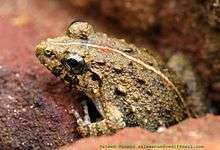Fejervarya limnocharis
Fejervarya limnocharis is a species of frog found in South East Asia and parts of Indochina. It is known under many common names, including Boie's wart frog, rice field frog, and Asian grass frog. Molecular studies of the species complex (after Boulenger)[2] suggest that there may be multiple species involved.[3][4]
| Fejervarya limnocharis | |
|---|---|
 | |
| A cricket frog from India | |
| Scientific classification | |
| Kingdom: | Animalia |
| Phylum: | Chordata |
| Class: | Amphibia |
| Order: | Anura |
| Family: | Dicroglossidae |
| Genus: | Fejervarya |
| Species: | F. limnocharis |
| Binomial name | |
| Fejervarya limnocharis (Gravenhorst, 1829) | |
| Synonyms | |
|
Rana limnocharis Gravenhorst, 1829 | |
Description
Snout pointed, projecting beyond mouth. Canthus obtuse, loreal oblique, more or less concave. Internarial space is longer than interorbital width, which is much less than width of the upper eyelid. Tympanum distinct, half to two third the diameter of eye. Fingers obtusely pointed, first longer than second, subarticular tubercles very prominent. Tibiotarsal articulation reaches tympanum or naris. Toes obtuse or with slightly swollen tips, half webbed, subarticular tubercles small and prominent. Body with small tubercles, sometimes small longitudinal folds are present, ventrum smooth except belly and thighs which are granular posteriorly. Male with loose gular region, with brown or blackish W-shaped mark, fore limbs stronger, with pad like subdigital tubercles under first finger. Snout-vent length 39–43 mm.
Color: Gray brown or olive above, sometimes suffused with bright carmine; a V-shaped dark mark between eyes, a yellow vertebral stripe mostly present; lips and limbs barred, a light line along calf, thighs laterally yellow, marbled with black, ventrum white, throat is mottled with brown in male.
The species forms a complex with several genetic variants that may represent multiple species.[5][6]

Distribution
A species inhabiting parts of South East Asia and Indochina.
Earlier, due to misidentification, this species was erroneously and extralimitally reported from South Asia but later have been found to be in error. According to the Amphibian Species of the World, records outside Indonesia, Malaysia, Thailand, Burma, Cambodia, Laos, and Vietnam are almost certainly representing other species.[3]
Fejervarya limnocharis is one of the few frog species commonly found in oil palm plantations in Malaysia, in addition to Microhyla heymonsi and Hylarana erythraea.[7]
Consumption
Fejervarya limnocharis is commonly sold as food in Southeast Asia, including Thailand, Laos, and Cambodia. In Cambodia, it is frequently collected for human consumption, along with Hoplobatrachus rugulosus, Glyphoglossus molossus, Kaloula pulchra, Duttaphrynus melanostictus, and Pelophylax lateralis (with P. lateralis found only north of the Mekong River in localities such as Snuol District, Kratie Province).[8]
References
- Peter Paul van Dijk; Djoko Iskandar; Robert Inger; Michael Wai Neng Lau; Zhao Ermi; Geng Baorong; Sushil Dutta; Kelum Manamendra-Arachchi; Anslem de Silva; Sabitry Bordoloi; et al. (2009). "Fejervarya limnocharis". IUCN Red List of Threatened Species. 2009. Retrieved 22 July 2013.CS1 maint: ref=harv (link)
- Boulenger, G. A. (1920). "A monograph of the South Asian, Papuan, Melanesian and Australian frogs of the genus Rana". Records of the Indian Museum. 20: 1–226.
- Frost, Darrel R. (2013). "Fejervarya limnocharis (Gravenhorst, 1829)". Amphibian Species of the World 5.6, an Online Reference. American Museum of Natural History. Retrieved 22 July 2013.
- Veith, M., J. Kosuch, A. Ohler, and A. Dubois. (2001). "Systematics of Fejervarya limnocharis (Gravenhorst, 1829) (Amphibia, Anura, Ranidae) and related species. 2. Morphological and molecular variation in frogs from the Greater Sunda Islands (Sumatra, Java, Borneo) with the definition of two species". Alytes. Paris (19): 5–28.CS1 maint: multiple names: authors list (link)
- M Kotaki, A Kurabayashi, M Matsui, W Khonsue, TH Djong, M Tandon, M Sumida (2008) Genetic Divergences and Phylogenetic Relationships Among the Fejervarya limnocharis Complex in Thailand and Neighboring Countries Revealed by Mitochondrial and Nuclear Genes. Zoolog Sci 25: 381-90.
- Mohammed Mafizul Islam, Md Mukhlesur Rahman Khan, Djong Hon Tjong, Mohammad Shafiqul Alam, Masayuki Sumida (2008) Genetic Differentiation of the Fejervarya limnocharis Complex from Bangladesh and Other Asian Countries Elucidated by Allozyme Analyses. Zoolog Sci. 25(3):261-72
- Faruk A, Belabut D, Ahmad N, Knell RJ, Garner TW (2013). "Effects of oil-palm plantations on diversity of tropical anurans". Conserv Biol. 27 (3): 615–24. doi:10.1111/cobi.12062. PMID 23692022.
- An Investigation into Frog Consumption and Trade in Cambodia
External links
| Wikimedia Commons has media related to Fejervarya limnocharis. |
